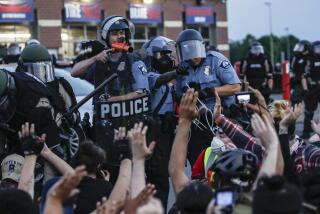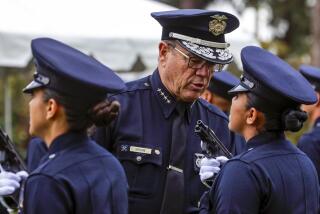Justice Department training police chiefs on bias and officer behavior
While the Justice Department’s Civil Rights Division has been investigating the shooting of Michael Brown and the practices of the Ferguson Police Department, a different agency at Justice has been providing training to local police and assessing their response to demonstrations.
The office of Community Oriented Policing Services (COPS) recently held a two-day training session for top police commanders on how bias can affect officers’ behavior. It has sent police chiefs with experience in similar situations to Ferguson to help city and county law enforcement officials.
But much of the federal help has just gotten underway, and some of those involved are concerned there has not been enough time to make the changes that are necessary. Their worries come as Ferguson awaits the grand jury decision on whether Officer Darren Wilson will be indicted in the Aug. 9 shooting of the unarmed Brown.
“Here we are right smack dab up against potential crisis No. 2 and they are just starting up the appropriate changes,” said Rick Myers, chief of police in Newport News, Va. “My heart goes out to them -- it’s really a difficult situation.”
He said police and community leaders were still traumatized by the August unrest.
“Both sides are pretty shell-shocked right now,” he said.
“I’m fearful that much of the preparatory work that would have made a significant difference is probably in the early stages and [new demonstrations] would tax those relationships” between the community and the police, he said.
Myers, as the former interim police chief in Sanford, Fla., handled demonstrations after the 2012 shooting death of Trayvon Martin. In Sanford the police had over a year after the shooting to train and prepare for the trial of George Zimmerman, who killed Martin and was acquitted of murder charges.
Myers was one of four police chiefs flown to Ferguson by the Justice Department weeks after Brown was killed. He met with the two top police officers in Ferguson and community and police leaders from St. Louis County and the city of St. Louis, he said.
“I will say it was very evident that the events had really taken a toll on the individuals involved,” Myers said. “Many of the police chiefs have suffered harassment and very disruptive behaviors that spilled over to their whole families.”
He said that the chiefs focused on the “optics” of the heavily armed police response to the demonstrations and how it affected the demonstrations. “I’m pretty sure the local police have put a lot time into thinking about tactics and the optics of them,” he said.
Ronald Davis, director of the COPS office at Justice, said in an interview that 27 top police commanders and community representatives spent two days in training sessions with experts brought in by Justice on Nov. 6-7.
Additional training sessions will be scheduled for rank-and-file police officers and then for police who will be taught how to train their fellow officers on bias issues, he said.
He said it was a “candid discussion” of bias and its impact that “was very well received.”
Asked if it would have been better to do the training earlier, Davis said that technical assistance started within days of the shooting and that his office was engaged in a long-term effort to achieve a cultural shift in the local departments and to “achieve commitments to systemic changes.” The program may last for two years, he said.
“It’s not an overnight process,” Davis said. “It’s not designed to change behavior for a specific event.”
Asked whether he expected the local police response to be better, Davis said he could not make any predictions. He and other officials said Justice wants to provide as much support as possible but it will be up to the local police to take advantage of it.
At the same time, a different team of experts has recently begun an assessment of local police agencies that handled the demonstrations in the roughly two weeks after the shooting, Davis said. That report will be made public once it is completed in about three months, he said.
“We will be looking at the decision making process and how things were implemented,” Davis said.
More to Read
Start your day right
Sign up for Essential California for news, features and recommendations from the L.A. Times and beyond in your inbox six days a week.
You may occasionally receive promotional content from the Los Angeles Times.







